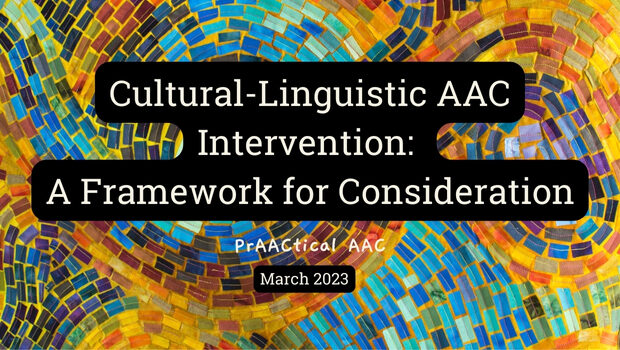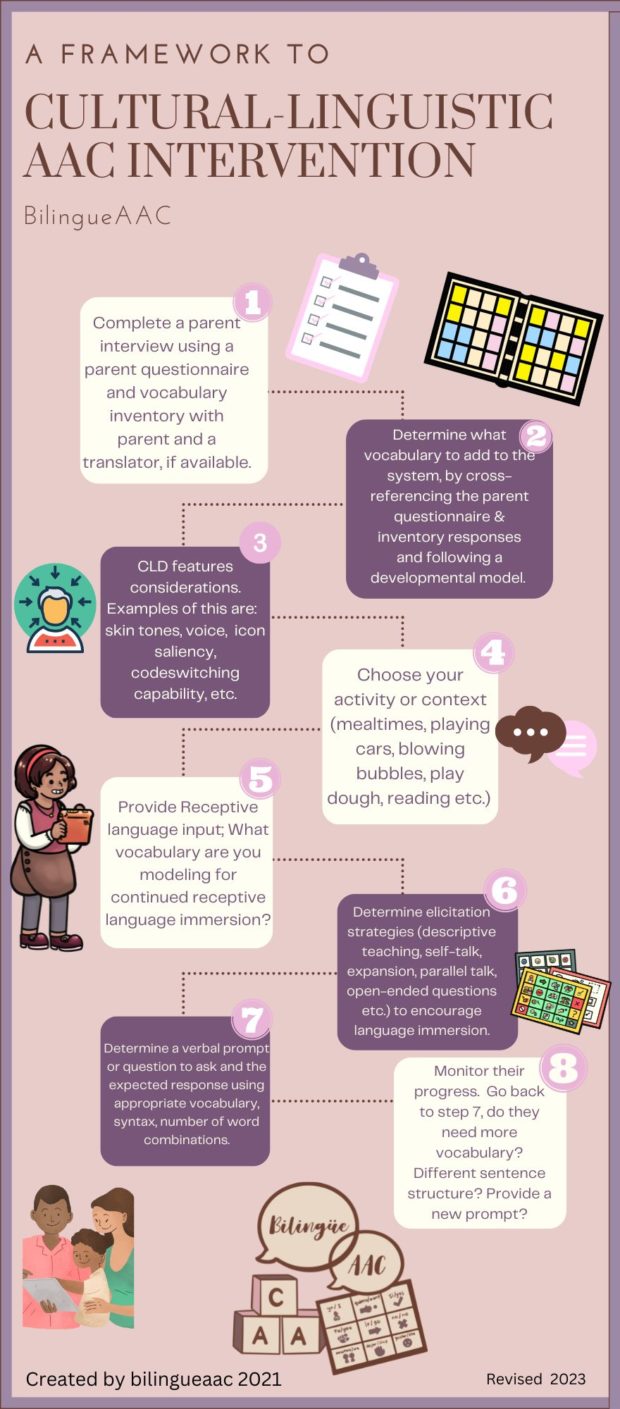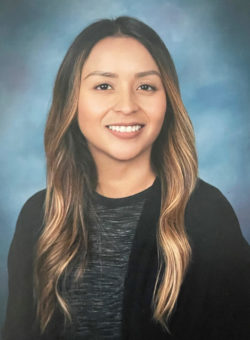Cultural-Linguistic AAC Intervention: A Framework for Consideration

We are pleased to publish the second post in a series on multilingual AAC support guest authored by BilingüeAAC. BilingüeAAC is a group of SLPs with a shared belief in providing evidence-based intervention strategies and resources to bilingual Spanish AAC clients, families, caregivers, and professionals. In today’s post, they introduce us to their framework for AAC intervention that is culturally and linguistically affirming.
BilingueAAC Framework to Cultural-Linguistic AAC Intervention
Bilingualism in AAC is the best practice and essential to equitable communication access for people with complex communication needs (McNamara, 2018). However, resources are limited to implementing “best practices” and the “how to” incorporate bilingualism and AAC. When we look at the research, we find a variety of cultural considerations (ASHA) but no definite guideline or framework on how to approach assessment and implementation for AAC users with linguistically diverse backgrounds.
Providing bilingual AAC intervention is an inclusive and equitable practice. Bilingual AAC intervention is essential in providing access to people with complex communication needs (McNamara, 2018). Addressing the intersections of disability, accessibility, and heritage language through AAC intervention upholds ASHA’s statement on SLP’s Roles and Responsibilities: Develop and implement culturally and linguistically relevant intervention plans to maximize effective communication between individuals who use AAC and their communication partners across the lifespan.
However, to implement bilingual AAC, SLPs must understand the current literature on bilingualism.
Best practices for bilingual AAC implementation include but are not limited to the following:
- Forced monolingualism may lead to poor communication between AAC user and their families. It may impede learning opportunities and socialization that arise from family, community, and cultural exchanges (Kremer-Sadlik, 2005; Pena, 2016)
- Learning a second language does not impair or slow learning the second language. Research suggests no significant difference exists between bilingual and monolingual children with specific language impairments, and they perform similarly in standardized tests (Bruck, 1998; Paradis et al., 2013). Additionally, children with bilingual communication disorders or children exposed to two languages may benefit from a bilingual approach to intervention (Gutierrez-Clellen, 1999; Kohnert, 2013)
- Language learning outcomes have less to do with the number of languages they learn. Instead, it is about the conditions under which language is learned. This includes the level of support for bilingualism at school and in the community, the quality of exposure to both languages, and the types of measures used to monitor language growth (Soto & Yu, 2014)
- Understanding cultural beliefs and perspectives on disability and AAC of a family unit will lead us to adjust our implementation strategies (Parette & Brotherson, 2004).
- Core words in English do not always translate correctly to high-frequency words used in other languages. Due to variations in grammatical structure, lexical items such as copulas, auxiliary verbs, pronouns, etc., which are frequently part of core vocabulary lists in any given language, may be represented differently and be acquired in a different order in different language typologies (Bornstein et al., 2004; Łuniewska et al., 2016; Soto & Cooper, 2021).
BilingueAAC has created a framework or guideline for AAC practitioners as a reference to use for all AAC users. The framework highlights AAC best practices to include and consider cultural and linguistic perspectives. We created this with the intention for it to be used as the initial steps of AAC Assessments and/or implementation.
Below are the steps of a framework:
- Complete a parent interview using a parent questionnaire and vocabulary inventory with the parent and a translator.
- Questionnaires and surveys should include questions about cultural practices, language exposure, language proficiency, perceptions of disability, and a specific vocabulary inventory of words and common phrases used at home. (Check out the BilingueAAC questionnaire and survey), Additionally, the MacArthur-Bates Communicative Development Inventories (CDIs) and the corresponding Spanish-language Inventarios can be used as a vocabulary inventory tool to collect vocabulary.
- Determine what vocabulary and features (code-switching) to add to the system by cross-referencing the parent questionnaire & inventory responses and following a developmental model.
- We want to remember that vocabulary selection depends on many factors that follow best practices in AAC vocabulary selection. AAC users should have different words available, e.g., nouns, verbs, adjectives, pronouns, pre-stored phrases, etc.
- Keep Customizing! What CLD features will you consider? Add culturally relevant and personal/home vocabulary to students’ AAC system (e.g., food, holidays, words specific to country/state, codeswitching, skin tone, voice, icon saliency, etc.) Check out BilingueAAC Operational Features Checklist.
- Use questionnaires and vocabulary inventories or take advantage of just-in-time (JIT) technology that allows you to add vocabulary on the spot when you learn new, commonly used vocabulary.
- Time to practice! Choose your activity or context (mealtimes, playing cars, blowing bubbles, play dough, reading, etc.)
- The activity of your choice. This can include activities of daily living, e.g., bathing, meal times, dressing, etc., or specific activities you have planned for intervention.
- Especially if you are a monolingual therapist, preparing a structured time with specific vocabulary can help identify specific Spanish vocabulary to target.
- Provide receptive language input. What vocabulary are you modeling without expectation for continued receptive language immersion?
- Follow AAC implementation best practices! Provide aided language input using the vocabulary on the system—model words in English and Spanish. Check out bilingueaac.com for Easy-to-use activity
- Additionally, collaborate with a translator or family for suggestions on appropriate syntax and grammar (i.e., gender (el/la), verb conjugation, etc.). Remember that you do not have to be an expert in the language to do modeling. You are not teaching the language but supporting native language use and the AAC user’s translanguaging skills.
- Determine elicitation strategies (descriptive teaching, self-talk, expansion, parallel talk, open-ended questions, etc.) to encourage language immersion.
- Use a variety of scaffolding/implementation strategies for successful AAC use.
- Continue providing evidence-based elicitation strategies just as we do for monolingual English-speaking AAC users.
- Explicit instruction: Determine a verbal prompt, a question to ask, and the expected response using appropriate vocabulary, syntax, and number of word combinations.
- How will you elicit language? Language output is as equally as important as language input. With this in mind, provide the AAC user with opportunities to practice using their vocabulary system in English and the native language. The practitioner can lead the session in English but accept productions in English and the native language.
- Monitor their progress. Go back to step 7. Do they need more vocabulary? Different sentence structure? Provide a new prompt.
BilingueAAC Framework Considerations
It is important to note that the framework steps 1-2 are best implemented early in the AAC evaluation or intervention. Steps 3-8 are fluid, and you can navigate the steps in any order. The framework presented here is a guideline to assist practitioners in approaching a culturally-linguistic intervention to AAC. If you are an SLP doing AAC language intervention, you probably already incorporate many of these steps and strategies. The only difference is that the framework allows us to look at AAC intervention and assessment from a cultural and linguistic lens.

:::::::::::::::::::::::::::::::::::::::::::::::::::::::::::::::::::::::::::::::::
About the Guest Author: Maria De Leon M.S., CCC-SLP , Co-Founder of BilingueAAC
- Maria De Leon is a bilingual Speech-Language Pathologist specializing in AAC. She received her Bachelor’s degree in Sociology at the
 University of California Los Angeles and her Master’s degree in Speech-Language Pathology at San Francisco State University. She participated in “Project Building Bridges” and graduated with a specialization in culturally responsive AAC. Maria currently works at a non-profit organization as a speech-language pathologist providing AAC services to Southern California. She focuses on giving back to communities like the one she grew up in and spreading information about best cultural practices. Maria manages the Instagram account, @code.switch.slp.
University of California Los Angeles and her Master’s degree in Speech-Language Pathology at San Francisco State University. She participated in “Project Building Bridges” and graduated with a specialization in culturally responsive AAC. Maria currently works at a non-profit organization as a speech-language pathologist providing AAC services to Southern California. She focuses on giving back to communities like the one she grew up in and spreading information about best cultural practices. Maria manages the Instagram account, @code.switch.slp. - BilingüeAAC: www.BilingueAAC.com
- Instagram: @bilingueaac
- Facebook Group: BilingüeAAC
- TPT: BilingueAAC
:::::::::::::::::::::::::::::::::::::::
You can view the first post in this series, Bilingual AAC Support from Monolingual Professionals: An Introduction, here.
Filed under: Featured Posts, PrAACtical Thinking
This post was written by Carole Zangari
